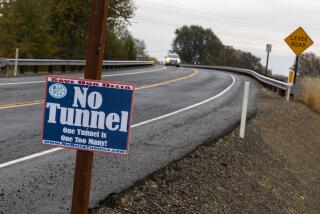Britain, France Plan Channel Rail Tunnels
- Share via
LILLE, France — In a decision that could break the historic and geographic isolation of Britain, Prime Minister Margaret Thatcher and President Francois Mitterrand of France announced approval Monday of an enormous $6.6-billion project to realize an engineering dream of old--the linking of Britain to France by two railroad tunnels beneath the English Channel.
In a ceremony and news conference at the town hall of Lille, a northern, economically depressed city that will benefit with the start of construction, Thatcher and Mitterrand disclosed that they have chosen the least expensive and least elaborate of the proposals submitted to them by four engineering and financial consortiums.
Mitterrand described construction of the 31-mile tunnels 131 feet beneath the seabed from Cheriton, near Folkestone in England, to Frethun, near Calais in France, as “the largest civil engineering project of the 20th Century.” No underwater tunnels of greater length have ever been completed.
When the tunnels are ready for use in 1993, trains would go straight through while motorists would drive their cars on to special shuttles moving over the same tracks.
If no snags develop and the tunnels open as scheduled, it will be the realization of a 200-year-old dream. The idea of linking the British Isles to Europe was first proposed in a scientific paper written by a French engineer in the middle of the 18th Century. Later, both Napoleon and Britain’s Queen Victoria expressed some support for the idea.
The project has twice seemed near realization. Digging went on in both the 1880s and more recently in the 1970s. The first digging was halted by a public outcry in Britain provoked by fears that the tunnel could be used by French troops to invade. The second was halted when the Labor government of Prime Minister Harold Wilson decided that there was not enough money to finance the project.
The latest announcement, which will take formal effect with the signing of a treaty in London next month, was turned into a festive occasion. Thatcher and Mitterrand spoke to government ministers, local officials and the press in an auditorium festooned with huge British and French flags. Bagpipers and a band played airs and marches as the two leaders walked together to the podium.
Although the announcement of the projects are expected to help leaders politically in the short run, especially in France where Mitterrand’s Socialist Party faces critical parliamentary elections March 16, both stressed more lofty themes while discussing the tunnels.
“One should not underestimate the symbolic significance of this project,” said Mitterrand, “a grandiose vision for the future.”
Centuries of Discussion
“It is a great day,” Thatcher said. “This proposal of a link between England and France has been talked about for centuries.” She called approval of the project “a dramatic step in Anglo-French relations” and said it symbolizes that “the United Kingdom is part of the whole of Europe.”
In a departure from most major European construction projects, the two tunnels will not be financed by either government. Instead, they will be built by a private consortium, with funds from private sources.
The promoters of the tunnels estimate that they will use more than 40,000 workers during the construction.
In Britain, the decision to build only rail tunnels was regarded as a kind of defeat for Thatcher, who was known to favor a bridge or tunnel for cars as well but gave in to French insistence on the rail lines. Perhaps to assuage her, the joint announcement held out some hope of a future, additional road link.
The British-French communique said the successful consortium, the Channel Tunnel Group and France Manche, would have to submit a proposal by the year 2000 for a road link between the two countries. If it failed to do so, Mitterrand said, other companies could submit proposals for a future automobile route. But Channel Tunnel Group and France Manche would still keep their monopoly over cross-channel links until 2020.
In About 3 Hours
The consortium estimated that France’s TGV, the high-speed express trains, could make the trip from Paris to London through an underchannel tunnel in a little more than three hours. The fastest present cross-channel system, by train and Hovercraft, requires more than five hours to cover the distance. The journey by train and ferry takes seven hours or so.
On the channel’s frequently rough waters, many boat passengers complain of seasickness, as Queen Victoria did in the 19th Century.
Analysts have noted two potential problems with the rail-tunnel scheme. Strikes by the rail unions could paralyze them. And cars could be held up if too many tried to board the shuttles at the same time. The first problem may be difficult to deal with, but the consortium said it plans to be able to load 4,000 cars an hour on its shuttles--a more than adequate capacity, in its view.
Channel Tunnel is made up of a group of British construction companies and banks, while France Manche-- manche or “sleeve” is what the French call the channel--is made up of a group of French construction companies and banks. Their consortium intends to seek financing with the help of outside lenders in Britain, the United States and Japan.
Construction of the tunnels is scheduled to begin in mid-1987 and end in the spring of 1991. Almost two years of final fittings and construction of the shuttle system is planned before the tunnels are opened to the public.
The three proposals rejected by Mitterrand and Thatcher were an elaborate scheme of bridges, sea islands and a tunnel for cars with a longer separate tunnel for trains; a system of parallel tunnels for cars and trains, and a plan for a bridge across the channel for cars and an underwater tunnel for trains.
More to Read
Sign up for Essential California
The most important California stories and recommendations in your inbox every morning.
You may occasionally receive promotional content from the Los Angeles Times.













